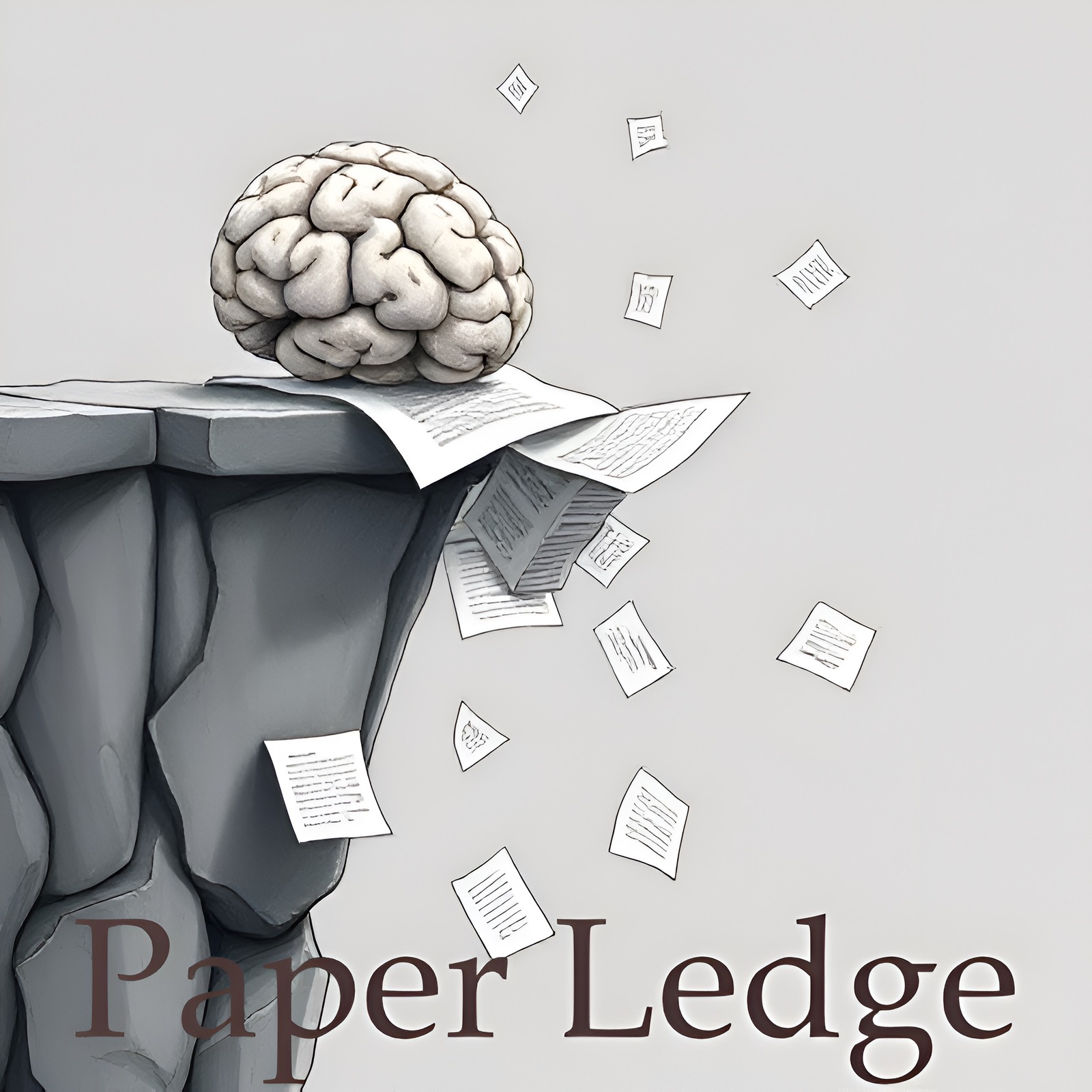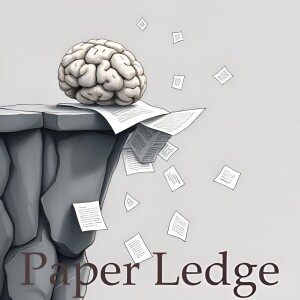PaperLedge

PaperLedge where research meets storytelling is a revolutionary podcast where cutting-edge research meets AI-powered storytelling. Hosted by the Ernis, whose blend of gentle reassurance, cosmic wonder, explanatory clarity, and enthusiastic charm makes complex research accessible to everyone. Each episode, Ernis transforms the latest academic papers into engaging, jargon-free audio experiences that deliver key insights in digestible formats. Whether you’re a researcher seeking interdisciplinary perspectives, a student supplementing your studies, or simply curious about scientific breakthroughs, PaperLedge has something for you.
Episodes
Episodes



Wednesday Oct 29, 2025
Wednesday Oct 29, 2025
Alright learning crew, Ernis here, ready to dive into some cutting-edge tech that could change how we navigate our cities! Today, we're talking about infrastructure-based perception – sounds fancy, but think of it as giving our roads and cities a super-powered set of eyes.
Imagine this: instead of relying solely on the sensors in our cars, what if the roads themselves could see everything happening? That's the idea behind this research. We're talking about cameras strategically placed around intersections and highways, creating a kind of all-seeing, all-knowing network. This network could then feed information to self-driving cars, traffic management systems, and even emergency services, making everything safer and more efficient.
The challenge? Getting all those cameras to work together seamlessly. You see, it's not like setting up a home security system. These cameras are all different – different angles, different resolutions, even different weather conditions affecting their view. Traditional camera-based detection systems often struggle with this kind of complexity.
That's where MIC-BEV comes in. Think of MIC-BEV as a super-smart translator for all these different camera views. It's a system that takes the images from multiple cameras and stitches them together into a bird's-eye view (BEV) – a top-down perspective that makes it much easier to understand what's happening on the road. Think of it like switching from a bunch of security camera feeds to a Google Maps-style view of the entire area.
"MIC-BEV...integrates multi-view image features into the BEV space by exploiting geometric relationships between cameras and BEV cells alongside latent visual cues."
Now, the secret sauce here is something called a Transformer. Forget Optimus Prime – this Transformer is a type of neural network that's really good at understanding relationships between different pieces of information. In this case, it's understanding how the different camera angles relate to each other and to the overall road layout. It's like having a detective that can piece together clues from multiple witnesses to get the full picture.
The researchers even created a special simulated environment called M2I to train and test MIC-BEV. M2I is like a video game version of a city, complete with different road layouts, weather conditions, and camera setups. This allowed them to push MIC-BEV to its limits and see how well it performed in a variety of challenging situations.
And the results? Pretty impressive! MIC-BEV outperformed existing systems in 3D object detection, even when the cameras were dealing with things like heavy rain or blurry images. This means it's not just accurate, but also robust – it can handle real-world conditions.
So, why does this matter? Well, for self-driving car enthusiasts, it means safer and more reliable autonomous navigation. For city planners, it means better traffic management and resource allocation. And for all of us, it means potentially fewer accidents and a smoother commute.
But here are a couple of things that popped into my head:
What are the privacy implications of having this kind of widespread camera surveillance? How do we balance safety and efficiency with individual rights?
And how do we ensure that these systems are fair and unbiased? Could certain communities be disproportionately affected by infrastructure-based perception?
This research opens up some exciting possibilities, but it also raises some important questions that we need to consider as we move forward. You can check out the code and dataset at the link in the show notes. Until next time, keep learning!Credit to Paper authors: Yun Zhang, Zhaoliang Zheng, Johnson Liu, Zhiyu Huang, Zewei Zhou, Zonglin Meng, Tianhui Cai, Jiaqi Ma



Wednesday Oct 29, 2025
Wednesday Oct 29, 2025
Hey learning crew, Ernis here, ready to dive into another fascinating paper! Today, we're talking about how well computers really understand sound. You know, we've got all these amazing AI models that can chat with us, write stories, and even create art, but how good are they at truly listening and understanding the world through sound alone? That's what this paper tackles.
Think about it: humans are incredible at picking up subtle cues from sound. We can tell if a car is speeding towards us, even if we can't see it. We can understand the rhythm of someone's footsteps and know if they're happy or upset. We can even pinpoint where a sound is coming from, even in a crowded room. This paper argues that current AI, despite all its advancements, isn't quite there yet.
The researchers point out that a lot of existing tests for audio AI only check if the AI can understand the meaning of a sound, something that could be described in words. For example, an AI might be able to identify the sound of a dog barking, but can it understand the dynamics of that bark? Is the dog barking aggressively? Is it far away or close by? Is the bark changing over time? These are the kinds of nuanced details that are much harder to capture in a simple caption.
To really test an AI's understanding of sound, the researchers created a new benchmark called STAR-Bench. Think of it as a really tough exam for audio AI. It's designed to measure what they call "audio 4D intelligence," which is basically the ability to reason about how sounds change over time and in 3D space.
STAR-Bench has two main parts:
Foundational Acoustic Perception: This part tests the AI's ability to understand basic sound attributes, like how loud a sound is, how high or low the pitch is, and how it changes over time. It tests both absolute judgments ("how loud is this sound?") and relative comparisons ("is this sound louder than that sound?"). The team uses synthesized and simulated audio to make sure the test is accurate.
Holistic Spatio-Temporal Reasoning: This is where things get really interesting. This part challenges the AI to understand how sounds relate to each other in time and space. For example:
Can the AI understand a sequence of sounds even if they're played out of order? Imagine hearing the sound of a glass breaking, then someone gasping, then the sound of sweeping up broken glass. Can the AI reconstruct the event even if the sounds are jumbled?
Can the AI pinpoint the location of a sound source? Can it track the movement of a sound source over time? Can it understand the relationship between multiple sound sources?
The researchers were very careful to create high-quality data for STAR-Bench. They used a combination of computer-generated sounds and real-world recordings, and they even had humans listen to the sounds and answer questions to make sure the test was fair and accurate.
So, what did they find? Well, the results were pretty revealing. They tested 19 different AI models, and they found that even the best models still have a long way to go to match human performance. Interestingly, they discovered that simply giving the AI a text description of the sound didn't help much. In fact, performance dropped significantly when the AI was forced to rely on captions, showing that STAR-Bench really is testing something different than just semantic understanding.
Specifically, the AI models showed a much larger performance drop on STAR-Bench compared to other benchmarks when relying on text captions alone (-31.5% for temporal reasoning and -35.2% for spatial reasoning). This underlines the test's emphasis on those hard-to-describe, non-linguistic elements.
They also found that there's a hierarchy of capabilities. The closed-source models, like those from big tech companies, were limited by their ability to perceive fine-grained details in the sound. The open-source models, on the other hand, struggled with perception, knowledge, and reasoning.
So, why does all this matter? Well, it highlights the need for AI models that can truly understand the world through sound. This could have huge implications for:
Robotics: Imagine a robot that can navigate a complex environment using only sound.
Accessibility: AI that can help people with visual impairments better understand their surroundings.
Security: Systems that can detect suspicious activity based on subtle audio cues.
Environmental monitoring: Tracking animal populations or detecting illegal logging based on soundscapes.
STAR-Bench provides a valuable tool for measuring progress in this area and helps guide the development of more robust and intelligent AI systems.
This paper really gets you thinking, right? Here are a couple of things that popped into my head:
Given the current limitations of AI in understanding audio dynamics, how might we better leverage human-AI collaboration to solve problems that require nuanced auditory perception? Could we build systems where humans and AI work together, each contributing their unique strengths?
Since the benchmark revealed different limitations in closed-source vs. open-source models, what does this say about the different priorities and resources in their development, and how might we encourage a more balanced approach to progress in audio AI?
That's all for this episode, learning crew! I hope you found this paper as fascinating as I did. Until next time, keep exploring!Credit to Paper authors: Zihan Liu, Zhikang Niu, Qiuyang Xiao, Zhisheng Zheng, Ruoqi Yuan, Yuhang Zang, Yuhang Cao, Xiaoyi Dong, Jianze Liang, Xie Chen, Leilei Sun, Dahua Lin, Jiaqi Wang



Wednesday Oct 29, 2025
Wednesday Oct 29, 2025
Hey PaperLedge learning crew, Ernis here, ready to dive into some fascinating research! Today, we're tackling a paper that's all about making AI search agents smarter, especially when they're tackling really complex questions. Think of it like training a super-powered research assistant that can sift through tons of information to find the answers you need.
So, these AI search agents are often trained using something called synthetic data – basically, artificial examples designed to teach them how to think. A common method called Group Relative Policy Optimization, or GRPO for short, is used. The thing is, GRPO mainly focuses on whether the final answer is right or wrong. It's like grading a test solely on the final answer, ignoring all the work you showed to get there. And the paper we're looking at today argues that this is a big missed opportunity!
Imagine you’re baking a cake. GRPO only cares if the cake tastes good in the end. But what if you almost got it right? Maybe you used the right ingredients and followed most of the steps, but slightly overbaked it. GRPO would treat that as a complete failure, even though you were super close! The paper argues that we're throwing away valuable information by not recognizing these "near-misses."
"We address this by leveraging the very entities discarded during training."
The researchers found something really interesting: there's a strong link between how many correct pieces of information (or "entities") the AI uses during its reasoning process and whether it gets the final answer right. In our cake analogy, this is like saying that the more of the correct ingredients and steps you use, the more likely you are to get a good cake, even if it’s not perfect.
Based on this, they developed a new method called Entity-aware Group Relative Policy Optimization, or E-GRPO. The "Entity-aware" part is key. It means the AI now gets rewarded not just for the final answer, but also for how many correct information pieces it uses along the way. It's like giving partial credit on the cake – you get points for using the right flour, sugar, and oven temperature, even if the final product isn't perfect.
This is a big deal because it allows the AI to learn from its near-misses. It can see what it did right and adjust its approach to improve its chances of success next time. It’s like learning from your mistakes in real-time!
So, what were the results? Well, the researchers tested E-GRPO on various question-answering tasks, and it consistently outperformed the original GRPO method. Not only was it more accurate, but it also came up with more efficient reasoning strategies. It’s like finding a shortcut that helps you bake the cake faster and with less effort.
Why does this matter?
For researchers: This provides a new way to train AI search agents to be more effective and efficient.
For businesses: This could lead to better AI-powered tools for research, customer service, and decision-making.
For everyone: This could eventually help us access information more easily and solve complex problems more effectively.
This research is super interesting because it shows how we can improve AI by focusing on the reasoning process, not just the final outcome. It's like teaching someone how to think, rather than just telling them what to think.
Here are a few things that popped into my head while reading this:
Could this entity-aware approach be applied to other areas of AI, like image recognition or natural language processing?
How do we ensure that the "entities" used for reward are actually correct and unbiased?
What are the ethical implications of using AI search agents to gather and process information, especially when dealing with sensitive topics?
That's all for today's episode. I hope you found this as fascinating as I did. Until next time, keep learning!Credit to Paper authors: Yida Zhao, Kuan Li, Xixi Wu, Liwen Zhang, Dingchu Zhang, Baixuan Li, Maojia Song, Zhuo Chen, Chenxi Wang, Xinyu Wang, Kewei Tu, Pengjun Xie, Jingren Zhou, Yong Jiang



Wednesday Oct 29, 2025
Wednesday Oct 29, 2025
Hey everyone, Ernis here, and welcome back to PaperLedge! Today, we're diving into a fascinating piece of research that's all about making AI agents really smart, like, "pass-the-hardest-exam-ever" smart. The paper's about how we can train these Large Language Models, or LLMs, to tackle problems they can't quite solve on their own yet.
Think of it like learning to ride a bike. You can't just hop on and go, right? You need someone to give you a little push, offer some guidance. This paper uses a similar idea, based on something called the "Zone of Proximal Development," or ZPD. Basically, the ZPD is that sweet spot where a task is just a bit too hard to do alone, but totally achievable with some help.
The researchers created something called the "AgentFrontier Engine," which is a fancy name for a system that automatically generates training data that sits right inside an LLM's ZPD. It's like a personalized curriculum designed to push the AI's boundaries.
How does it work? Imagine you're trying to teach an AI about, say, complex chemistry problems. The AgentFrontier Engine would create problems that are just a little bit beyond what the AI already knows. But it also provides hints, explanations, or related information to help the AI bridge that gap. It's not just about throwing hard questions at it; it's about providing the right kind of support to help the AI learn.
This Engine can be used in two main ways:
Continued Pre-training: Giving the AI more knowledge in general using this ZPD-focused method. It's like sending the AI back to school, but with a super-targeted curriculum.
Targeted Post-training: Honing the AI's reasoning skills on specific, complex tasks. Think of it as specialized coaching for a particular sport.
The coolest part? They also built a “ZPD Exam.” This isn't your typical multiple-choice test. It's a dynamic benchmark that adapts to the AI's abilities, continuously challenging it with frontier tasks. It's like a video game that gets harder as you level up!
So, they trained an LLM, called AgentFrontier-30B-A3B, using all this ZPD-generated data. And guess what? It aced some incredibly difficult benchmarks, including "Humanity's Last Exam." It even outperformed some of the top-secret, proprietary AI agents out there!
Why does this matter?
For developers: This shows a new, more effective way to train AI agents, leading to more powerful and capable models.
For researchers: It offers a framework for understanding and pushing the boundaries of AI reasoning.
For everyone else: More capable AI could lead to breakthroughs in fields like medicine, education, and climate change.
"Our work demonstrates that a ZPD-guided approach to data synthesis offers a scalable and effective path toward building more capable LLM agents."
Basically, this research shows that by carefully crafting training data that's just a bit beyond an AI's current capabilities, and providing the right kind of support, we can unlock its full potential. It’s like being a good teacher, understanding where your student is at, and pushing them to grow just beyond their current abilities!
So, what do you guys think? Here are a couple of things that popped into my head:
Could this ZPD approach be applied to other areas of AI development, beyond just language models?
How do we ensure that the "guidance" provided by the AgentFrontier Engine doesn't inadvertently introduce biases into the AI's reasoning?
Let me know your thoughts in the comments! Until next time, keep learning!Credit to Paper authors: Xuanzhong Chen, Zile Qiao, Guoxin Chen, Liangcai Su, Zhen Zhang, Xinyu Wang, Pengjun Xie, Fei Huang, Jingren Zhou, Yong Jiang



Wednesday Oct 29, 2025
Wednesday Oct 29, 2025
Hey learning crew, Ernis here, ready to dive into another fascinating paper that could change how we interact with AI! Today, we're tackling a challenge that's been bugging researchers in the world of AI web agents – specifically, how these agents remember and use information over long periods.
Imagine you're trying to bake a complicated cake following an online recipe. You're constantly scrolling back and forth, trying to remember if you added the sugar or not. That's kind of what's happening with current AI web agents.
These agents, often built on something called ReAct, are amazing at finding information online and completing tasks. But they have a memory problem. They tend to just pile up all the information they encounter, creating a huge, messy "memory log." This is like trying to find that one specific ingredient in a kitchen overflowing with clutter. It gets slow, confusing, and ultimately, they make mistakes.
On the other hand, some agents try to solve this by summarizing everything constantly. This is like throwing away ingredients you think you don’t need, only to realize halfway through the recipe that you actually needed that weird spice! They lose important details forever.
Problem 1: Agents' memory gets cluttered with irrelevant information.
Problem 2: Agents lose crucial details when summarizing too aggressively.
Now, here's where the cool part comes in. The researchers behind this paper came up with a clever solution called AgentFold. Think of it like a master chef who knows exactly what to keep, what to toss, and how to organize the kitchen for maximum efficiency.
AgentFold is inspired by how we humans remember things. We don't just record everything that happens. We actively manage our memories, focusing on the important bits and consolidating the rest. AgentFold does the same for AI agents.
At each step, AgentFold decides how to "fold" its memory. It can:
Granular Condensation: Keep the really important details, like the exact temperature for baking a specific pastry.
Deep Consolidation: Summarize entire sub-tasks, like "Mixed dry ingredients," so the agent doesn't have to remember every single step involved.
It's like having a dynamic, actively managed cognitive workspace instead of a passive memory log.
“AgentFold treats its context as a dynamic cognitive workspace to be actively sculpted, rather than a passive log to be filled.”
So, what were the results? They're pretty impressive! The researchers trained AgentFold (specifically, a version called AgentFold-30B-A3B) and tested it on some tough web browsing tasks. It blew away the competition, even outperforming much larger AI models, including proprietary systems like OpenAI’s o4-mini! This shows that intelligent memory management is often more effective than just throwing more computing power at the problem.
Specifically, AgentFold achieved 36.2% on BrowseComp and 47.3% on BrowseComp-ZH. To put it in perspective, it's like going from barely passing a test to acing it simply by improving your study habits!
Why does this matter?
For Researchers: This opens up new avenues for developing more efficient and capable AI agents without relying solely on massive models.
For Developers: This offers a practical approach to building AI assistants that can handle complex tasks requiring long-term memory.
For Everyone: Imagine AI assistants that can truly understand your needs and preferences over time, helping you with everything from planning a vacation to managing your finances more effectively.
This research highlights that smart memory management is crucial for AI agents to truly excel. It's not just about having a big brain; it's about knowing how to use it effectively!
So, a few questions that popped into my head while reading this:
Could AgentFold be adapted to other types of AI, like those used in robotics or autonomous driving, where remembering past experiences is critical?
How can we ensure that the "folding" process doesn't inadvertently filter out information that's important but not immediately obvious?
What ethical considerations arise when AI agents can selectively remember and forget information, potentially leading to biased or manipulative behavior?
That's all for today's deep dive! I hope you found AgentFold as fascinating as I did. Let me know your thoughts and questions in the comments below. Until next time, keep learning and keep exploring!Credit to Paper authors: Rui Ye, Zhongwang Zhang, Kuan Li, Huifeng Yin, Zhengwei Tao, Yida Zhao, Liangcai Su, Liwen Zhang, Zile Qiao, Xinyu Wang, Pengjun Xie, Fei Huang, Siheng Chen, Jingren Zhou, Yong Jiang



Wednesday Oct 29, 2025
Machine Learning - Greedy Sampling Is Provably Efficient for RLHF
Wednesday Oct 29, 2025
Wednesday Oct 29, 2025
Hey PaperLedge crew, Ernis here, ready to dive into some fascinating AI research! Today, we're cracking open a paper that’s all about how we teach those big language models – think GPT-4 or Gemini – to be more helpful and less… well, let's just say "robot-y."
The secret sauce is called Reinforcement Learning from Human Feedback, or RLHF. Basically, instead of just feeding the AI tons of text, we get humans to tell it what's good and what's bad. Think of it like training a puppy: you reward the good behavior and discourage the unwanted ones. It sounds simple, but getting this right is surprisingly tricky.
Now, the paper tackles a specific challenge in RLHF: how to efficiently learn what humans want. Imagine you’re trying to teach your smart speaker to play your favorite music. You could give it a thumbs up or thumbs down to each song it suggests. The AI then uses this feedback to get better at predicting your taste.
Previous research often relied on something called the Bradley-Terry (BT) model, which assumes that whenever you compare two options (two song suggestions, for example), one is inherently better than the other. This paper says, "Hold on a minute! What if our preferences aren't so clear-cut?" What if you like one song on Monday and another on Tuesday?
This research uses a more general preference model, which is like admitting that human taste is complex and nuanced! The really cool part is that the researchers found a way to improve the learning process without relying on overly optimistic or pessimistic assumptions, which is what previous methods did. It's like saying, "Instead of always guessing the best-case or worst-case scenario, let's just look at the data we have!"
And guess what? It turns out that this straightforward approach -- what they call greedy sampling -- works surprisingly well! This is because the best way for the AI to behave is structurally simple. It’s like realizing that the shortest distance between two points really is a straight line, even when you thought you needed a fancy, curved path. The researchers even showed that this simple greedy sampling is good enough for the Bradley-Terry model.
"This insight has a deep root in the unique structural property of the optimal policy class under the KL-regularized target..."
Okay, I know that sentence sounds like pure jargon! Let’s break it down. "Optimal policy class" just means the best way for the AI to behave. "KL-regularized target" is a fancy way of saying we want the AI to be helpful without going completely off the rails and generating crazy, nonsensical stuff. So, what they're really saying is that there's a surprisingly simple and elegant solution to this problem of aligning AI with human preferences.
Why should you care?
For AI enthusiasts: This research offers a more efficient way to train AI models, potentially leading to better, more helpful AI assistants.
For developers: The paper suggests simpler algorithms for RLHF, which could make it easier to implement and deploy these techniques.
For everyone: Ultimately, better RLHF means AI that’s more aligned with our values and preferences, leading to more useful and less problematic AI systems.
So, what questions does this paper bring up for you? Here are a couple of things I was pondering:
How much does this improved efficiency translate into real-world cost savings when training these massive language models?
If greedy sampling works so well, are there other areas of AI where we might be overcomplicating things?
That's all for this episode, PaperLedge crew! Keep learning, keep questioning, and I'll catch you next time with another deep dive into the world of research!Credit to Paper authors: Di Wu, Chengshuai Shi, Jing Yang, Cong Shen



Wednesday Oct 29, 2025
Wednesday Oct 29, 2025
Hey PaperLedge crew, Ernis here, ready to dive into some seriously cool research! Today, we're unpacking a paper about how to make AI problem-solvers way more effective, especially when they're digging for information.
Think of it like this: Imagine you're trying to find the best recipe for chocolate chip cookies. You could just follow one recipe really, really carefully, tweaking it bit by bit to make it perfect. That's like a regular AI agent, focusing deeply on one path. But what if there were other amazing recipes out there you're missing?
This paper introduces a new approach called ParallelMuse. It's all about exploring multiple cookie recipes at the same time – that's the 'parallel thinking' part. The researchers noticed that AI, when searching for answers, often restarts its thinking process from scratch, which is super inefficient. It's like baking a whole new batch of cookies every time you want to try a slight variation. Plus, it's hard for the AI to remember why it made certain choices along the way.
So, how does ParallelMuse solve these problems?
Functionality-Specified Partial Rollout: This is like breaking down each cookie recipe into steps – mixing the wet ingredients, adding the dry ingredients, baking. Then, instead of redoing everything for each recipe, you only change the parts that are different. Maybe you use brown butter in one, and regular butter in another. This saves a ton of time and ingredients – or in the AI's case, processing power. They use uncertainty-guided path reuse and branching, which is fancy talk for saying they figure out which steps are most likely to lead to better cookies and focus on those.
Compressed Reasoning Aggregation: Imagine you've tried a bunch of different cookie recipes, and you've got notes scribbled everywhere about what worked and what didn't. This part of ParallelMuse is like having a super-smart assistant who can read all your notes, find the common threads, and then combine the best parts into a single, ultimate cookie recipe. The AI identifies and compresses the most important reasoning steps, making it easier to come up with the best final answer without getting bogged down in unnecessary details.
The results are pretty impressive! The researchers found that ParallelMuse improved performance by up to 62% compared to other AI agents, while also using 10-30% fewer resources. That's like getting way better cookies while using less flour and sugar!
"Experiments across multiple open-source agents and benchmarks demonstrate up to 62% performance improvement with a 10--30% reduction in exploratory token consumption."
Why does this matter?
For AI developers: This offers a powerful new technique for building more efficient and effective AI agents.
For businesses: Think of AI-powered customer service or research tools – ParallelMuse could make them faster, cheaper, and more accurate.
For everyone else: As AI becomes more integrated into our lives, improvements like this can lead to better problem-solving in all sorts of areas, from medical diagnosis to climate change research.
Now, this research raises some interesting questions:
Can ParallelMuse be applied to all types of problem-solving, or are there specific situations where it works best? For example, would it be effective in creative endeavors, like writing a novel?
How does the "compression" aspect of ParallelMuse affect the AI's ability to explain its reasoning? Is there a risk of losing valuable insights in the process?
Could we use ParallelMuse to help humans think more effectively, by encouraging us to explore multiple ideas in parallel and then synthesize them into a coherent solution?
That's ParallelMuse in a nutshell! A fascinating approach to making AI smarter and more efficient. I'm curious to hear your thoughts, PaperLedge crew. What do you think of this parallel thinking approach? Let's discuss!Credit to Paper authors: Baixuan Li, Dingchu Zhang, Jialong Wu, Wenbiao Yin, Zhengwei Tao, Yida Zhao, Liwen Zhang, Haiyang Shen, Runnan Fang, Pengjun Xie, Jingren Zhou, Yong Jiang



Wednesday Oct 29, 2025
Wednesday Oct 29, 2025
Hey PaperLedge crew, Ernis here, ready to dive into another fascinating piece of research! Today, we're unpacking a paper that tackles a big challenge in training AI agents – specifically, how to get them to perform complex tasks like using tools, browsing the web, or even writing code.
Now, you might think we have tons of data to train these agents on, right? After all, the internet is overflowing with information. But the problem, according to this paper, isn't a lack of data, it's that the data is all over the place – scattered across different websites, apps, and systems, each with its own unique format. It's like trying to build a Lego castle when all your bricks are from different sets and don't quite fit together!
The researchers realized that what's needed is a translator – something that can take all this disparate data and convert it into a common language that AI agents can understand. Think of it like the Rosetta Stone, but for AI training data!
That's where the Agent Data Protocol (ADP) comes in. It's a lightweight, flexible system designed to represent a wide range of agent tasks, from simple API calls to complex coding projects. The beauty of ADP is that it's simple enough to parse and use for training without needing a ton of extra engineering work for each new dataset.
Imagine you're teaching a dog new tricks. You might use different commands and rewards, but the underlying principle is the same: show the dog what you want it to do, and reward it for doing it correctly. ADP does something similar, providing a consistent way to represent the 'instructions' and 'rewards' for AI agents across different tasks.
So, what did the researchers actually do? Well, they gathered 13 existing agent training datasets – a pretty diverse collection! – and converted them all into ADP format. Then, they used this standardized data to train AI agents. The results were impressive: they saw an average performance boost of around 20% compared to agents trained on the original, fragmented data. In many cases, their agents achieved state-of-the-art or near-state-of-the-art performance on standard coding, browsing, and tool-use benchmarks.
"We unified a broad collection of 13 existing agent training datasets into ADP format...and demonstrated an average performance gain of ~20% over corresponding base models."
The real kicker? They achieved all this without any special tweaking for specific tasks. The standardized ADP format allowed them to train a single agent that could excel at a variety of different challenges.
And, in the spirit of open science, they've released all their code and data publicly. Their hope is that ADP will lower the barrier to standardized, scalable, and reproducible agent training. Basically, they're making it easier for everyone to build better AI agents!
Why does this matter? Well, think about it: if we can train AI agents more efficiently and effectively, we can unlock a whole new range of possibilities. From automating tedious tasks to solving complex problems, the potential is enormous. This research brings us one step closer to that future.
For developers: ADP could significantly reduce the time and effort required to train AI agents for specific tasks.
For researchers: ADP provides a standardized framework for sharing data and comparing different training methods.
For everyone: This research contributes to the development of more capable and reliable AI systems that can benefit society as a whole.
But, as always, this research raises some interesting questions:
Could a standardized data format like ADP lead to a homogenization of AI agent behavior, potentially limiting creativity and innovation?
How can we ensure that ADP is used responsibly and ethically, especially when training agents for tasks that could have societal impact?
What are the long-term implications of making agent training data more accessible and standardized?
That's all for this episode of PaperLedge. Let me know what you think about this research – I'm always curious to hear your thoughts!Credit to Paper authors: Yueqi Song, Ketan Ramaneti, Zaid Sheikh, Ziru Chen, Boyu Gou, Tianbao Xie, Yiheng Xu, Danyang Zhang, Apurva Gandhi, Fan Yang, Joseph Liu, Tianyue Ou, Zhihao Yuan, Frank Xu, Shuyan Zhou, Xingyao Wang, Xiang Yue, Tao Yu, Huan Sun, Yu Su, Graham Neubig







